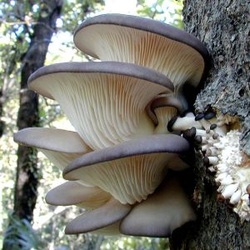
There's a fungus among us: I'm branching out in my gardening endeavors this year…
I’ve decided to grow my own mushrooms! I really enjoy eating mushrooms and would like to cook with them more often. There are the standard fungi that I can pick up at any supermarket, but I thought it might be fun to grow a variety or two that most folks spend an entire season foraging about the woods to find.
To that end, this week I purchased some inoculated plugs for 'Chicken of the Woods' and 'Lavender Oyster Mushrooms'. I also sprung for an easygrow 'Shiitake mushroom kit'. I’m really excited to get started!
A Short Primer on Mushrooms
Interestingly, having no roots, leaves, flowers or seed, mushrooms are neither plant nor animal. about 25% of them are poisonous, they don’t synthesize their own food from the energy of the sun the way plants do, they’re sort of a fruit by way of their growth habit, but according to their DNA they’re more closely related to animals. Odd little edibles…
And they’re very good for you (the non-poisonous varieties anyway). It’s a common myth that mushrooms have no nutritional value, but they have plenty. And some are even used to prevent and fight cancer. Mushrooms provide a good source of protein, fiber, a substantial amount of B vitamins, copper, and other minerals. They're sugar-free: one cup of raw mushrooms has only about 20 calories. They’re also are an excellent source of high quality protein with 8 essential amino acids. The average shroom contains about 35% by dry weight; compare this to 25% for milk and 13% for wheat.
Here are descriptions of the various mushrooms I’ll be growing:

One of the few edible shelf mushrooms, this unique fungus is a vivid orange-yellow color that is sometimes used to dye wool. Not to be confused with Hen of the Woods, this variety also grows in a semi-circular form around tree trunks or stumps. It's called the "chicken of the woods" because it tastes just like chicken meat and when cooked, the flesh sort of peels apart the same way chicken does. Eaten in its soft, velvety, fleshy stage, this is an excellent addition to your Meatless Monday dinner plate!
To prepare, clean the leafy sections thoroughly and cut away the woody core, so that you’re using only the young and tender parts. Cut these meaty lobes into 1/2-inch wide strips and cook them just like chicken. You can serve it up in any recipe that calls for poultry - rice, risotto, curry, chicken or turkey casseroles… you name it!

These also freeze really well: Chop into 1/2-inch strips, sauté or stir-fry in a wok until you get reddish brown edges (5-10 minutes on high). Chill, and freeze in 1/2 pound batches - then just re-heat when needed. It also holds its shape very well when canned.
,
,

Oyster mushrooms have been used for thousands of years as a culinary and medicinal ingredient. They contain glucosamine – chondroitin which is commonly used for prevention and relief from osteoarthritis and they’re loaded with ergothioneine, a unique antioxidant that protects our cells.
Oyster mushrooms have a chewy texture and a delicate, sweet flavor which can be used as a subtle flavoring agent in many recipes. Their sweet quality is not lost in cooking so when preparing in a baked noodle dish, its pleasant flavor mixes well with the other ingredients without losing intensity. Oyster mushrooms are often used in stir-fried dishes, since the cap is thin and cooks quickly. Asian chefs simply tear the mushroom into desirable sizes before adding it to their woks.
.

These freeze really well - briefly sauté in butter first. Oyster mushrooms dehydrate rapidly so use your food dehydrator to dry them thoroughly . When used dry, they can be added to a dish without re-hydration. Mushroom soups made from dried mushrooms are excellent and in most cases, better than fresh mushroom soup. Or you can add dehydrated oyster mushrooms to meat sauces for a robust flavor.
A strain of oyster mushrooms can even be used as an eco-friendly resource for oil spill cleanup – it can break down and digest oil with the ability to restore life to contaminated water or soil in as few as 6 weeks!
,

In China and Japan, medicinal use of shiitake mushrooms dates back beyond 100 AD. Today, they’re very popular all over the world and their rich, smoky flavor has endeared them to American taste buds. Still considered somewhat exotic, this hearty specialty mushroom is as mysteriously unique as it is delicious.
Determined by food science folks to be a very good, non-animal food source of iron (which boosts your energy level and prevents fatigue) by providing 20% of our daily value, a recent preliminary study has established that the bioavailability of iron from shiitake mushrooms may be even better than we originally believed.
Ongoing research since the 1960's has discovered some anti-cancer properties in this fascinating fungus. Compounds revealed within the shiitake mushroom are touted to work as an anti-tumor, cholesterol-lowering, and virus-inhibiting powerhouse. Because they contain interferon, a group of natural proteins that stops viruses from multiplying, shiitakes are promoted as a super immune booster, heart disease fighter, and a treatment for infections.
.

Prepare them by a gentle wipe with a damp cloth or a paper towel. Use a knife to remove the stems where they meet the cap. The stems are too fibrous to eat on their own, but they make an excellent addition to the stockpot. They dry well so you can preserve them for later. Before using dried shiitakes in a recipe, even if it's a soup or a stew, it's best to rehydrate them in hot water. The stems tend to be woody, so trim them off and discard (or dry and ground) after soaking.
.


 RSS Feed
RSS Feed



